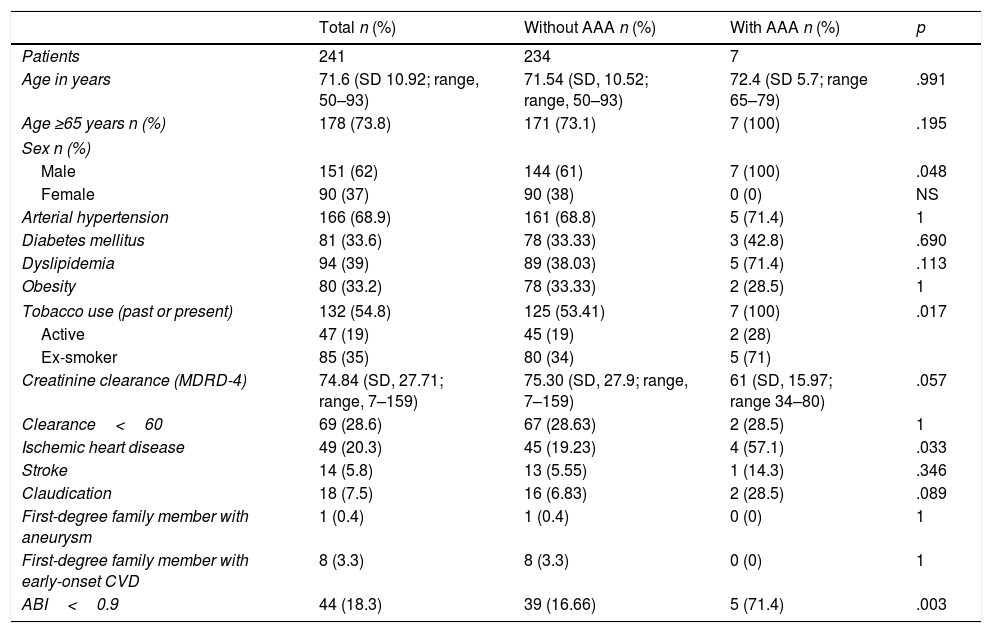To determine the prevalence of previously undiagnosed abdominal aortic aneurysm (AAA) in patients hospitalised in a department of internal medicine, as well as the associated risk factors.
Patients and methodsAn observational, cross-sectional, single-center, randomized study was conducted on 241 patients hospitalised in Internal Medicine. The patients were older than 50 years, had no previous diagnosis of AAA and underwent clinical ultrasonography. The dependent variable was the presence or absence of an aneurysm. The independent variables were age, sex, cardiovascular risk factors, cardiovascular disease, renal function, ankle brachial index (ABI), family history (first degree) of AAA or of early ischemic heart disease. A bivariate and multivariate analysis was conducted in the statistical analysis.
ResultsThe prevalence of AAA was 2.9% (95% CI: 0.8–5). The cases were confirmed through ultrasonography or computed tomography by the Department of Radiology. All patients were men with a history of smoking and with an age≥65 years. The bivariate analysis found an association between being male (OR, 9.39), smoking (OR, 13.08), ischemic heart disease (OR, 5.6; 95% CI: 1.21–25.91; p<.05) and ABI<0.9 (OR, 12.50; 95% CI: 2.34–66.77; p<.05). In the multivariate analysis, the independently associated variable was an ABI<0.9 (OR, 10.758; 95% CI: 1.968–58.815; p=.006).
ConclusionsThe prevalence of undiagnosed AAA in patients older than 50 years hospitalised in internal medicine was 2.9%. The data lead us to recommend AAA screening for this population of male patients with a history of smoking and an ABI<0.9. Clinical ultrasonography enables this screening in a reliable manner.
Determinar la prevalencia de aneurisma de aorta abdominal (AAA), no diagnosticado previamente, en pacientes ingresados en un Servicio de Medicina Interna, así como los factores de riesgo asociados.
Pacientes y métodosEstudio observacional, transversal, unicéntrico, aleatorizado de 241 pacientes ingresados en Medicina Interna, mayores de 50 años, sin diagnóstico previo de AAA. Se practicó una ecografía clínica. La variable dependiente fue la presencia o no de aneurisma. Las variables independientes fueron edad, sexo, factores de riesgo cardiovascular, enfermedad cardiovascular, función renal, índice tobillo-brazo (ITB), antecedente familiar de primer grado de AAA o de cardiopatía isquémica precoz. Se realizó un análisis bivariante y multivariante.
ResultadosLa prevalencia del AAA fue del 2,9% (IC 95%: 0,8-5). Los casos fueron confirmados mediante ecografía o TAC por el Servicio de Radiología. Todos fueron varones con antecedente de tabaquismo y con edad ≥ 65 años. En el análisis bivariante se asociaron ser varón (OR = 9,39), el tabaquismo (OR = 13,08), cardiopatía isquémica (OR = 5,6; IC 95%: 1,21-25,91; p < 0,05) e ITB inferior a 0,9 (OR = 12,50; IC 95% = 2,34-66,77; p < 0,05). En el análisis multivariante la variable asociada independientemente fue un ITB < 0,9 (OR: 10,758; IC 95%: 1,968-58,815; p = 0,006).
ConclusionesLa prevalencia de AAA no diagnosticado en pacientes mayores de 50 años ingresados en Medicina Interna fue del 2,9%. Los datos llevarían a recomendar el cribado de AAA en esta población de pacientes varones, con antecedente de tabaquismo y con un ITB inferior a 0,9. La ecografía clínica posibilitaría este cribado de forma fiable.
Article
Diríjase desde aquí a la web de la >>>FESEMI<<< e inicie sesión mediante el formulario que se encuentra en la barra superior, pulsando sobre el candado.

Una vez autentificado, en la misma web de FESEMI, en el menú superior, elija la opción deseada.

>>>FESEMI<<<






